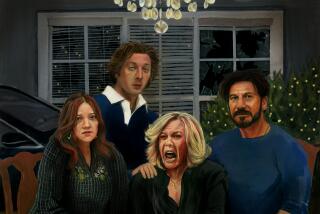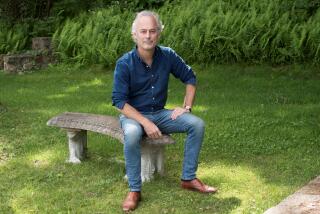Earl Hamner Jr. Comes Home
- Share via
John Boy Walton and Earl Hamner Jr. are pretty much one and the same; now they are about to step on stage together for the first time.
Hamner is the tall, genteel Virginian who created “The Waltons,” the heartwarming, long-running 1970s TV series about a large Southern clan making it through the Depression thanks to togetherness and moral fiber. John Boy, the budding writer, was Hamner’s alter ego on the program. In fact, everybody in the Walton family had a counterpart among the real-life Hamners of Schuyler, Va.
In the television series, each episode included a voice-over introduction and postscript in which John Boy, looking back as an established author, framed the action. Hamner provided that voice. Now, in his stage debut, Hamner is about to do the same tonight for the opening (and possibly some additional performances) of the Laguna Playhouse’s Youth Theatre production of “The Homecoming.”
Hamner published “The Homecoming” as a novel in 1970. The following year he wrote the teleplay for a two-hour Christmas special on CBS, which led to “The Waltons.” The television show ran from 1972 to 1981. Hamner, as executive producer, laid out the story arcs for the series and closely oversaw the scripts, which were written by others. It never occurred to him to adapt “The Homecoming” for the stage. But when playwright Christopher Sergel sought permission, Hamner agreed, and Sergel’s 1976 script has been a Christmas attraction in theaters ever since.
Hamner says he was first called upon to give voice to the grown-up John Boy when director Fielder Cook was dissatisfied with the voice-over specialists who auditioned for “The Homecoming” Christmas movie.
“Finally he said, ‘We need somebody as corny as Earl; I wonder what Earl would sound like?’ And I lived up to that compliment.”
“The Homecoming” is based on actual happenings in the Hamner household on Christmas Eve 1938, when Earl Jr. was 15. The Depression had forced his father to work at a factory 40 miles from home. Earl Sr.’s worried clan waited and waited--wife Doris, Earl Jr. and his seven younger siblings. The father finally arrived in the dead of night, bearing gifts and telling a tale for the little ones’ sake about having wrestled Santa Claus for the sack of presents. Young Earl’s gift was a package of writing tablets. It was his first inkling that his father understood that his penchant for writing was a serious calling.
The Hamner household contained just two books: the King James version of the Bible and “The History of Beekeeping.” Hamner says he always wanted to be a writer, but his father questioned whether that was any way to support a family. Years later, Earl Sr. attended the 1963 premiere of “Spencer’s Mountain”--based on his son’s novel--and laughed and cried and applauded while watching himself portrayed by Henry Fonda.
“That,” says Earl Jr., “was overwhelming proof that I would not neglect my family for my art.” For a long time, the alter egos of the Hamners were called the Spencers. Hamner says that was changed to the Waltons for television. In the Spencer versions, the budding writer is named Clay-Boy, not John Boy. The stage version of “The Homecoming” follows the novel in using the Spencer names.The early years of “The Waltons” were disillusioning, rancorous ones for America. Hamner says he did not consciously intend “The Waltons” as a pointed reminder that there also is a capacity for goodness and harmony in the national character.
“Maybe unconsciously I felt that the America that we were portraying, no matter how romanticized, was still as valid as [one defined by then-President Richard] Nixon or Vietnam. I’ve never been politically active, but I’ve always loved the history of the country, and in spite of some horrible things we’ve done, I’m proud. I think all of those things came out in the series.”
After “The Waltons,” Hamner scored again with “Falcon Crest,” a TV series that ran from 1981 to 1990 about a somewhat less functional family: owners of a Northern California winery who went to Machiavellian lengths of scheming and double-crossing in their struggle for control of the business.
“If you are a good writer--and I think I am--you are able to handle any kind of group and imagine their lives,” Hamner said.
John McGreevey, who wrote more than 20 episodes of “The Waltons” and became a fast friend of Hamner, recalls that Hamner became frustrated as TV opportunities dried up. “What was salable in television had changed, and he didn’t seem to be willing or able to make the switch that was necessary.” Hamner kept forging ahead with his work, however, decamping Down Under at one point to produce a series for Australian television.
In almost all regards, however, Hamner’s is a sunny tale. His 47-year marriage began with love at first sight (he and wife Jane have a son who is a writer and a daughter who is a family counselor). He achieved wealth and acclaim in the only career he ever wanted, and he continues to do the work he loves.
At 78, Hamner still works eight hours every weekday at the same office in Studio City that he has used for 40 years. On a large table across from his writing desk are eight stacks of papers, each pile a different work in progress.
Among them are volumes of stories and poetry, the script for a country-flavored musical based on one of the eight episodes he wrote for the original “Twilight Zone,” a play about one of his aunts, and several nonfiction works, including “Goodnight, John Boy,” which will explain the parallels between the Waltons and the Hamners.
“I’ve led a charmed life,” Hamner said. “I’ve known people who have been depressed, and I’ve never had that. I feel that problems are to be solved, and God knows I hope that continues.”
More to Read
The biggest entertainment stories
Get our big stories about Hollywood, film, television, music, arts, culture and more right in your inbox as soon as they publish.
You may occasionally receive promotional content from the Los Angeles Times.











